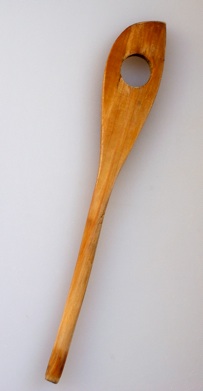
This spoon was specifically designed for stirring sauces. Its old-style simplicity is hard to find these days with bright colors and bizarrely shaped silicone utensils ruling the kitchen.
The hole would have prevented splashes on clothing, face and stove as a cook briskly stirred hot liquid. The off-center point made sure no delicate ingredients were left to sit and scorch in the corner of the pan, where the sides meet the bottom. If you’ve ever boiled jam or made an egg-based sauce, you know what I mean. My own 18-year-old wooden sauce spoon, which doesn’t conduct heat, feels lovely in my hands. It’s seen me through many a batch of lemon curd and polenta.
And in case you were wondering, the sloped sides of a Windsor pan helps sauces reduce quickly and evenly. The greater surface area at the top allows more liquid to evaporate quickly at the beginning, while the smaller surface area at the bottom lets busy, multi-tasking cooks monitor sauce reductions more closely as they near their finishing stages.
Home > What’s This? >


©2007 Thy Tran